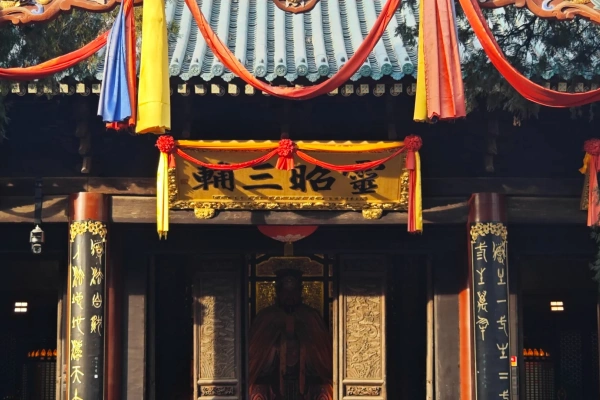Xi'an City God Temple
Historical Overview
1375: Constructed during the Ming Dynasty’s Hongwu reign, originally dedicated to the City God (Chenghuang Ye), a deity believed to protect urban areas.
1600s: Expanded under Qing Emperor Kangxi, adding the Hall of the Three Officials and the Opera Tower.
1911–1949: Survived republican-era upheavals, serving as a refuge for local communities during wartime.
1980s–2000s: Restored by the Xi’an government, preserving its Ming-Qing architectural style and reviving traditional festivals.
2010s–Present: Integrated into modern tourism, hosting international cultural exchanges and digital exhibitions on Taoism.
Structural Layout
The temple’s layout follows classical Taoist principles, with three main courtyards aligned along a central axis:
Front Courtyard: Features the Sacrificial Hall, where visitors offer incense to the City God, and the Drum Tower, used to announce ritual timings.
Middle Courtyard: Houses the Hall of the Three Officials (Tianguan, Diguan, and Shuiguan), deities governing heaven, earth, and water, surrounded by 12 zodiac statues.
Rear Courtyard: Includes the Hall of the City God’s Wife and the Treasure Pavilion, displaying ancient steles and ceremonial artifacts.
Side Wings: Contain the Opera Tower, where traditional Shaanxi opera is performed during festivals, and the Martial Arts Hall, showcasing historical weapons and calligraphy.

Major Attractions
Sacrificial Hall: A grand space with a 12-meter-high golden statue of the City God, adorned with dragon motifs and surrounded by 28 constellation deities.
Opera Tower: A 15-meter-tall wooden structure with intricate carvings, hosting free performances of Qinqiang opera every weekend.
Zodiac Courtyard: A serene garden with stone sculptures representing the 12 Chinese zodiac animals, each carved with Taoist symbols.
Ancient Stele Gallery: A collection of 50 stone inscriptions dating back to the Tang Dynasty, documenting the temple’s history and local legends.
Suggested Itineraries
Quick Cultural Visit (1–2 Hours):
Start at the Sacrificial Hall for incense offerings → Explore the Zodiac Courtyard → Watch a 20-minute opera excerpt at the Opera Tower → Visit the Ancient Stele Gallery.
Highlights: Iconic statue, zodiac sculptures, and live cultural performance.
Deep Dive into Taoism (3–4 Hours):
Begin with a guided tour of the Hall of the Three Officials → Participate in a tea ceremony at the Rear Courtyard → Attend a calligraphy workshop → Explore the Martial Arts Hall.
Highlights: Ritual explanations, interactive experiences, and historical artifacts.
All-Day Immersion (Full Day):
Morning: Join the 9 AM opening ceremony → Tour all three courtyards → Visit the Treasure Pavilion.
Afternoon: Enjoy a Shaanxi opera lunch show → Learn basic Tai Chi in the garden → Browse the temple’s artisan market.
Evening: Attend a lantern-lighting ritual (seasonal) → Dine at a nearby vegetarian restaurant.
Highlights: Full cultural engagement, local cuisine, and evening traditions.

Ticket Purchase
Online: Book via the official WeChat account "Xi’an Chenghuang Miao" up to 3 days in advance.
On-Site: Purchase at the entrance ticket office (open 8 AM–6 PM).
Prices: Standard Entry: ¥30 (includes a free incense stick).
Guided Tours: ¥100–200 per group (1-hour English/Chinese tours).
Free Admission: Children under 1.2m, seniors over 70, and disabled visitors.
Transportation
By Subway: Take Line 2 to Bell Tower Station (Exit C), then a 10-minute walk west along Xidajie Street.
By Bus: Routes 4, 7, 15, 32, or 205 to "Chenghuangmiao" Stop.
By Taxi: Direct to "Xi’an Chenghuang Miao"
Parking: Limited street parking available; nearby paid lots charge ¥5–10 per hour.
Best Time & Tips
Avoid Crowds: Peak Hours: 10 AM–2 PM (weekends/holidays).
Best Times: Early morning (8:30 AM) or late afternoon (4 PM) on weekdays.
Quietest Days: Tuesdays–Thursdays (Mondays open but less crowded).
Weather: Visit year-round; spring/autumn ideal for garden strolls.
Essentials: Download the temple’s AR guide app for audio explanations.
Wear Comfortable Shoes: The complex involves walking on uneven stone paths.
Respect Traditions: Avoid touching statues or taking photos during rituals.
Photography: Allowed everywhere except the inner sanctum of the Sacrificial Hall.
Prohibited Items: Large bags, pets, and outside food (snack stalls available on-site).

